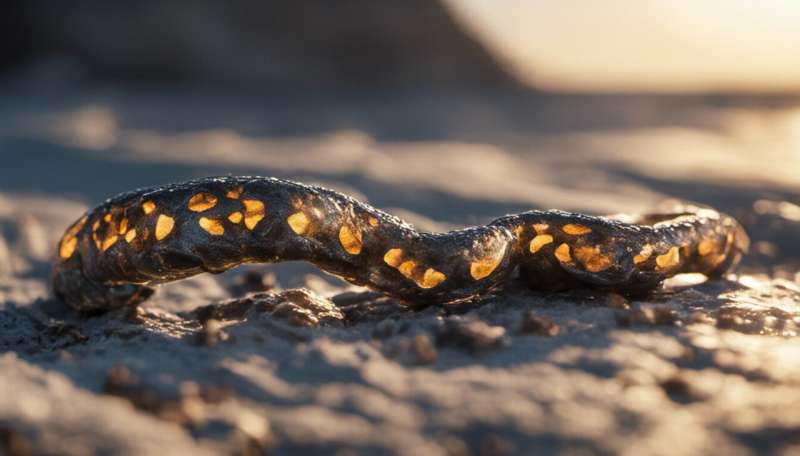This article has been reviewed according to Science X's editorial process and policies. Editors have highlighted the following attributes while ensuring the content's credibility:
fact-checked
trusted source
proofread
Animal heredity sheds light on survival and extinction risks

As biodiversity declines and causes reductions in the genetic variation of animals, historic genomes offer clues for conservation.
As recently as the early 1800s, thousands of Seychelles paradise flycatcher birds lived on at least five islands off the southeast coast of Africa.
By the 1960s, just 28 of the winged creatures were left and all lived on one island, La Digue.
Population and genetic losses
The small black birds, which feed on insects and spiders, were devastated by habitat loss, invasive species and hunting in the 19th and 20th centuries.
In recent years, as local conservation efforts have improved, the numbers have risen and La Digue is now home to more than 250 Seychelles paradise flycatchers. What's more, a viable breeding population has been established on another island and work is underway to introduce the bird to a third one in the archipelago.
Although the forest-dwelling birds are no longer considered critically endangered, the crash of their population has vastly reduced its genetic diversity.
"The question is: how did this species manage to not go extinct despite having this massive loss of genetic diversity?" said Hernán Morales, an evolutionary biologist at the University of Copenhagen in Denmark.
Biodiversity protection has shot up the EU agenda amid growing warnings that the world is undergoing a sixth mass extinction. Unlike the five earlier die-offs, including the most recent one 65 million years ago that killed off dinosaurs, the current mass extinction is driven primarily by human activity including land, water and energy use and pollution.
With the viability of whole ecosystems and animal species including humanity at stake, genomics has gained importance in assessing biodiversity and pursuing conservation.
Morales led a project that received EU funding to compare historic and modern genomes of Seychelles paradise flycatchers. It came to a startling conclusion: the birds suffered a 90% loss in their genetic diversity.
The initiative, called GENDANGERED, ran for two years through May 2022.
Past and current specimens
Morales specializes in evolutionary genomics.
This field typically involves looking at modern genomes—the complete set of genetic material in an organism—and using the information to draw conclusions about what happened to species in the past.
In GENDANGERED, he opted for a different approach: comparing historic genomes from specimens in museum collections across Europe with ones from current populations. The work covered 12 bird species—including the Seychelles paradise flycatcher—that have suffered a rapid fall in their numbers.
The museum samples were more than 100 years old and represented the pre-collapse state of the populations, according to Morales.
This information was used to create computer models that simulated how the genetic diversity of those species and their populations had changed over time.
There have never been huge numbers of Seychelles paradise flycatchers and the work on the museum material showed that they have always had low genetic diversity compared with other bird species.
Diversity dilemma
One of Morales's findings is counterintuitive: the species survived its population collapse as result of the relatively low genetic diversity.
To understand how this was possible—and why it marks both good and bad news for Seychelles paradise flycatchers—requires knowing two things.
First, genetic variation can have a positive, negative or neutral effect on a population. Second, Morales's research showed that population crashes tend to increase negative genes, reducing genetic health, because inbreeding—mating between very close relatives—increases.
As a result, in animals like the Seychelles paradise flycatcher with low genetic diversity to begin with, there are fewer negative genes to be amplified when population numbers plunge.
While this factor helped prevent the bird from going extinct, it isn't good news in the long term.
That's because, while negative genes increase in population crashes, positive and neutral genes often decline.
These genes, particularly the neutral ones, are important. They provide variation that helps species adapt to future challenges like environmental change and disease.
The loss of such genes can be particularly dramatic in animals with initially low diversity such as Seychelles paradise flycatchers.
"Now that they have very little variation left, we predict they will have a very rough time adapting to future environments," Morales said.
Conservation benefits
Larger populations with more genetic diversity face a different dilemma.
While Seychelles paradise flycatchers survived the plunge in their numbers because of low genetic diversity, Morales found that the risk of extinction for bigger, more diverse species occurs in the population drop itself.
The reason is that they have a much larger increase in negative genes during the population collapse and, as a result, are exposed to more harmful genetic variation.
These findings can bolster conservation efforts by showing whether species need more help during a population crash or afterwards, according to Morales.
For example, the insights could prevent wildlife organizations categorizing species like the Seychelles paradise flycatcher as doing well when they are in fact still at risk as a result of the erosion of their genetic diversity.

Ape discoveries
Genomics and historic samples can also be used to discover extinct species, which in turn can improve understanding of modern-day animals including where they live.
Tomàs Marquès Bonet leads the ApeGenomeDiversity project comparing samples from modern day-apes with historic specimens from museums across Europe. The five-year initiative runs through May 2025.
The goal is to "find new species of apes that are now extinct but bred with current species in the past," said Marquès Bonet, a genomics expert at Pompeu Fabra University in Barcelona, Spain.
The research could ultimately help protect modern apes from human hunters and collectors.
Every year thousands of apes are killed for bush meat or captured for the exotic pet trade. The genetic data could show where these apes were living when they were killed or captured.
The team is working with a primates conservation organization called the Pan-African Sanctuary Alliance to create a genetic atlas so that the origins of illegally trafficked apes can be determined.
Anti-poaching efforts could then be directed towards these locations.
Leftover samples
To expand their knowledge of ape genomes, Marquès Bonet and his colleagues have been using samples collected from ape excrement.
Such a non-invasive method has enabled them to collect many more samples than would otherwise be possible and to link genetics with location.
"We can clearly identify chimpanzees that belong to the northern distribution in a country or the southern distribution," Marquès Bonet said.
As was the case with GENDANGERED, the museum specimens in ApeGenomeDiversity are at least 100 years old and represent more genetically diverse populations.
All this information will help scientists understand the origins and dynamics of genomic variants in living apes and how these factors contribute to the genetic landscape of modern-day populations.
Because apes are the closest living relatives to people, the data could even expand knowledge of humankind's own genome.
More information:
Provided by Horizon: The EU Research & Innovation Magazine

















